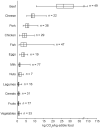Perspective: Striking a Balance between Planetary and Human Health-Is There a Path Forward?
- PMID: 34849542
- PMCID: PMC8970843
- DOI: 10.1093/advances/nmab139
Perspective: Striking a Balance between Planetary and Human Health-Is There a Path Forward?
Erratum in
-
Corrections.Adv Nutr. 2022 Oct 2;13(5):2064. doi: 10.1093/advances/nmac045. Adv Nutr. 2022. PMID: 36183243 Free PMC article. No abstract available.
Abstract
The global adoption of predominantly plant-based, sustainable, healthy diets will help reduce the risk of obesity- and malnutrition-related noncommunicable diseases while protecting the future health of our planet. This review examines the benefits and limitations of different types of plant-based diets in terms of health and nutrition, affordability and accessibility, cultural (ethical and religious) acceptability, and the environment (i.e., the 4 pillars underlying sustainable healthy diets). Results suggest that, without professional supervision, traditional plant-based diets (vegan, vegetarian, and pescatarian diets) can increase the risk of nutritional deficiencies among infants, children/adolescents, women, pregnant/lactating women, and the elderly. In contrast, flexitarian diets and territorial diversified diets (TDDs; e.g., Mediterranean and New Nordic diets) that include large quantities of plant-sourced foods, low amounts of red meat, and moderate amounts of poultry, fish, eggs, and dairy can meet the energy and nutrition needs of different populations without the need for dietary education or supplementation. Compared with vegan, vegetarian, and pescatarian diets, more diverse flexitarian diets and TDDs are associated with reduced volumes of food waste and may be more acceptable and easier to maintain for people who previously followed Western diets. Although flexitarian diets and TDDs have a greater impact on the environment than vegan, vegetarian, and pescatarian diets, the negative effects are considerably reduced compared with Western diets, especially if diets include locally sourced seasonal foods. Further studies are required to define more precisely optimal sustainable healthy diets for different populations and to ensure that diets are affordable and accessible to people in all countries.
Keywords: environment; flexitarian; plant-based diets; sustainable healthy diets; territorial diversified diet; vegan; vegetarian.
Copyright © 2021 © The Author(s) 2021. Published by Oxford University Press on behalf of the American Society for Nutrition. Published by Elsevier Inc. All rights reserved.
Figures




References
-
- Food and Agriculture Organization of the United Nations . The future of food and agriculture—alternative pathways to 2050 [Internet]. Rome (Italy): FAO; 2018. Available from: https:ca1553en.pdf (accessed May 2021).
-
- Willett W, Rockstrom J, Loken B, Springmann M, Lang T, Vermeulen S, Garnett T, Tilman D, DeClerck F, Wood Aet al. . Food in the Anthropocene: the EAT-Lancet Commission on healthy diets from sustainable food systems. Lancet North Am Ed. 2019;393(10170):447–92. - PubMed
-
- WHO . A Comprehensive Global Monitoring Framework, including indicators, and a set of voluntary global targets for the prevention and control of noncommunicable diseases, 2012 [Internet]. Available from: https://www.who.int/nmh/events/2012/discussion_paper2_20120322.pdf (accessed May 2021).
-
- Food and Agriculture Organization of the United Nations/WHO . Sustainable healthy diets: guiding principles, 2019 [Internet]. Available from: www.who.int/publications/i/item/9789241516648 (accessed May 2021).

